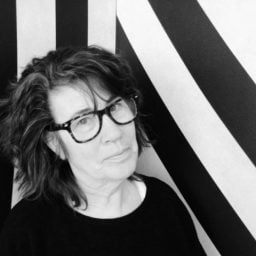Art & Exhibitions
At a Rare Giorgio Morandi Exhibition in New York, 60 Quiet Masterpieces Illuminate His Legacy
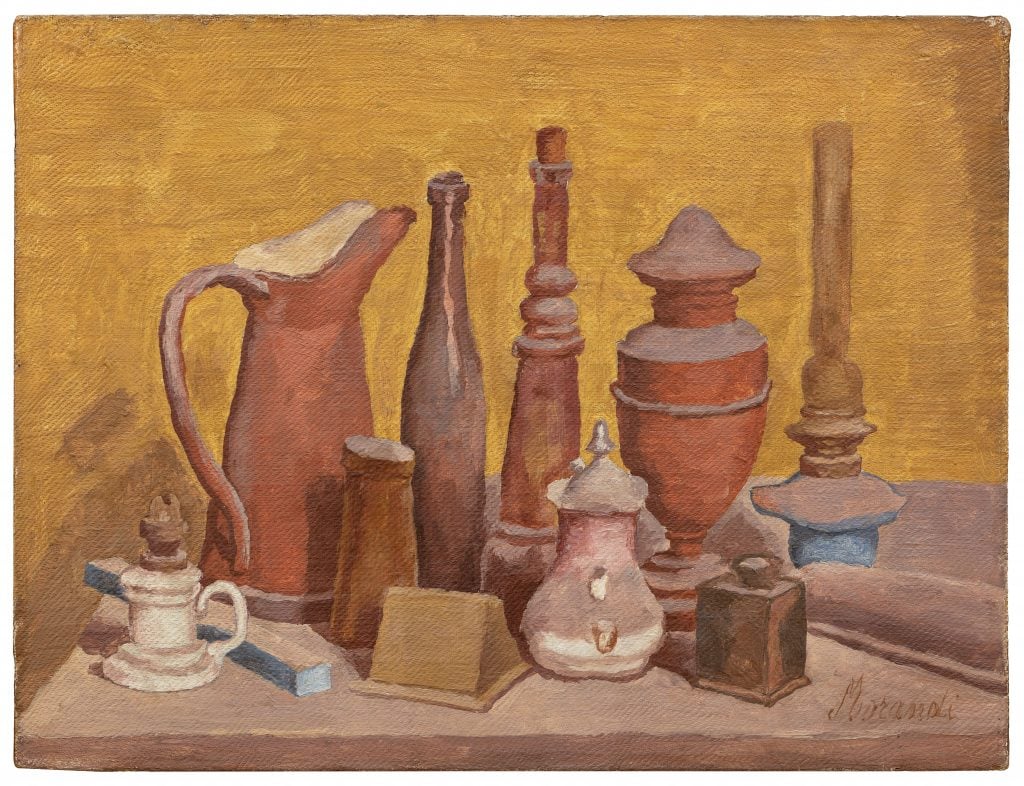
Celebrating 60 years since Giorgio Morandi’s death, the Galleria Mattia De Luca has brought to New York a stunning exhibition of 60 works by the Italian painter and printmaker. Surprisingly, Morandi has not had a major show in the city since 2008 when the Met held a retrospective of his work. More lauded in Europe than in the United States, his oeuvre is now given just the right venue, in a 19th century townhouse on East 63rd Street off Fifth Avenue.
Newly renovated by curator and dealer Mattia De Luca, the wooden floors and panels, white walls, and brick fireplaces, with large inviting windows, make for the perfect setting for Morandi’s small paintings. Here you can feel what it would be like to have a Morandi hanging on your own walls, which is where his work belongs. Unfortunately, most of Morandi’s work is in private hands or in museums, rarely coming up for auction. “Owners are attached to the work and you rarely see any Morandi for sale, only minor works,” Mattia said. This exhibit is a rare opportunity to be up close to the deep beauty.
Along with Marilena Pasquali, founder and director of the Giorgio Morandi Study Center in Bologna, they were able to procure 27 paintings. In the spring of 2022, “Giorgio Morandi – Time Suspended I” opened at the Galleria Mattia De Luca’s Rome headquarters. “Giorgio Morandi – Time Suspended II,” in New York, is also curated by Mattia and Pasquali and will run through November 27, 2024. “A number of paintings have never been shown in New York,” Mattea said. “We are thrilled to be showing 48 paintings, five etchings, four watercolors, and some drawings.”
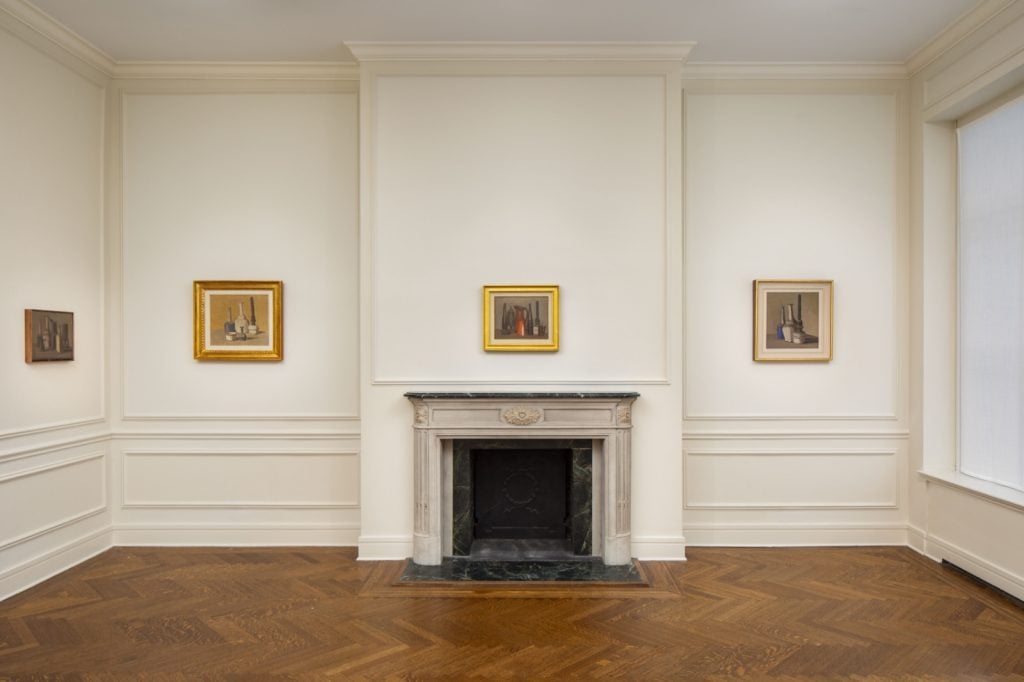
Installation view by Nicholas Knight
Love at First Sight
Speaking with Mattia on a tour through the exhibit, it is clear he is passionate about the artist and devoted to Morandi’s legacy. He pointed out nuances in the work that often go unnoticed. “Morandi’s signature on each painting is unique and specific. It is never casual, never random,” he said. “His signature is original to each work.”
In Fernado Pessoa’s The Book of Disquiet from 1982, he writes: “The visible world goes on as usual in the broad daylight. Otherness watches us from the shadows.” This is an apt description of Morandi’s painting; So many times during our conversation talking about the work, Mattia said that “it’s hard to put [the work] into words.” That is one of the beauties and power of Morandi’s pictorial universe—the otherness. Certainly there is tenderness, devotion, rigor, skill. The more you stand still in front of a Morandi, the more you can sense this otherness.
Mattia saw his first Morandi when his parents took him to a museum when he was 13. “I fell in love. Ever since, I try to see every exhibition that shows his work. I collect the catalogs and read everything I can about him.” In 2020, lockdown was very strict in Italy. “For three months, we couldn’t go out. It was tough. At that time, I felt Morandi was more relevant than ever—this suspended feeling of his work. The quiet. So I came up with the idea of putting on a Morandi show and began researching where the works were.” He contacted museums and collectors and found out how difficult it was to convince them to lend the work for an exhibition.
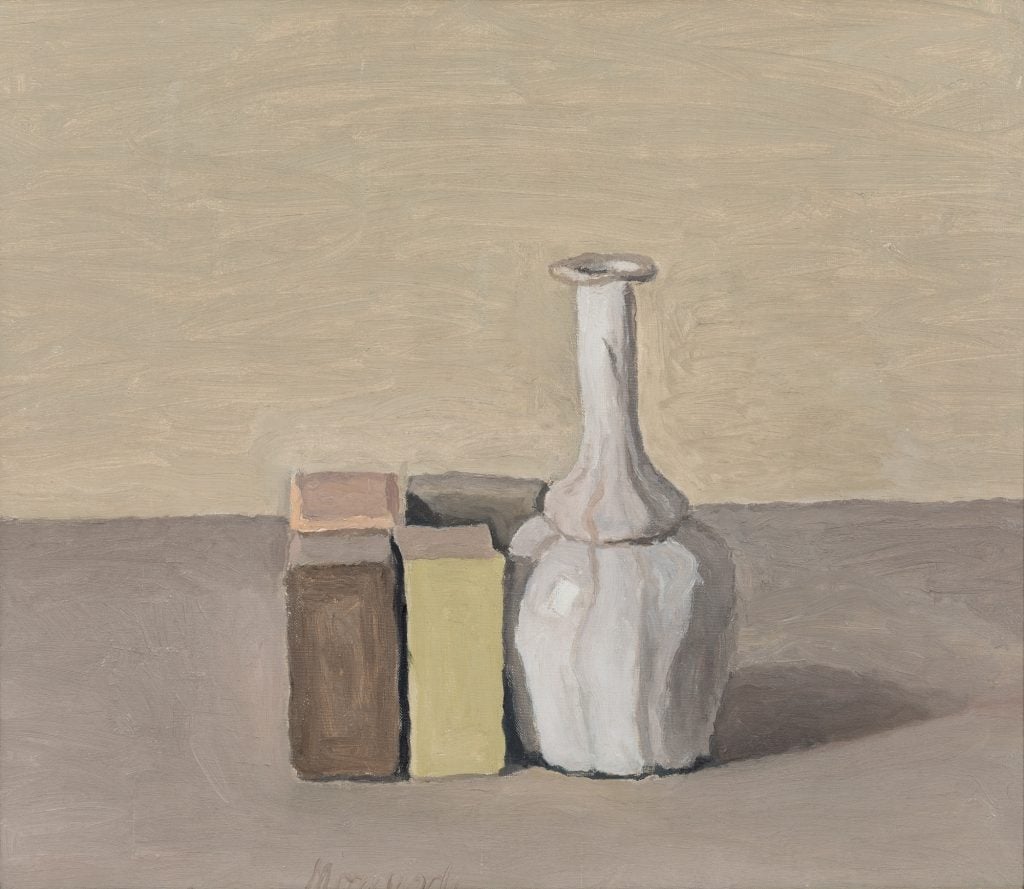
Giorgio Morandi Natura morta (V. 907) signed: “Morandi” (lower center). Executed in 1954 (undated)
An Artist’s Artist
Whether it is one Morandi’s signature still lifes, a landscape or etching, to spend time looking at the work offers many rewards. His work compels you to stop and be still, which is one of the allures. Mattia commented that “Morandi is an artist’s artist,” and you can understand why. One wants to stare long at the visible brushstrokes in flat white and grey, the warm pastels of brick, ochre, rose, the way he animates the objects as if they each have a distinct personality, and his ability to capture the streets of Bologna where he walked every day as well as the surrounding Emilian hillside.
Philip Guston, Vija Clemins, Frank Gehry, Wayne Thiebaud, Edmund de Waal, Joseph Cornell, Louise Nevelson, Fellini, Don DeLillo, all were influenced and inspired by the artist. “What makes Morandi so great is his ability to transfer emotions into objects, bringing them to life,” said Mattia. “In his early work, he was experimenting, more technical. As you move through the exhibit into his later work and toward the end of his life, you can feel his soul. In the last room, his 1960 still life with the bright white bottle in the center strongly holds the other objects. He was so grounded in his work.”
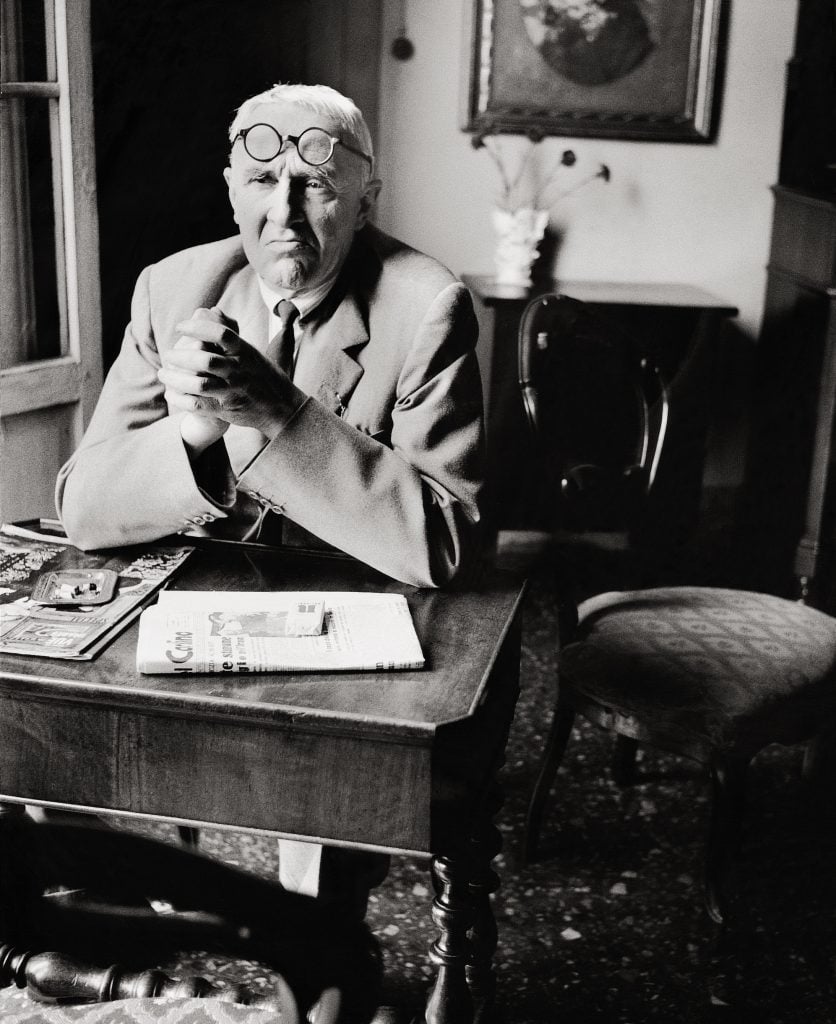
Painter Giorgio Morandi in his flat in Bologna. Photography. 1958. (Photo by Imagno/Getty Images) [Der Maler Giorgio Morandi in seiner Wohnung in Bologna. Photographie. 1958.]
The art historian, Roberto Longhi, described him as “arguably the greatest Italian painter of the 20th century.” Obama chose two oil paintings when he was president in 2009 by Morandi, now part of the White House Collection. Umberto Eco said, “Morandi reaches the peak of his spirituality as a poet of matter.”
Born in Bologna in 1890, Morandi lived through two world wars. Early in his life he traveled in Europe to study many great paintings. His hero was Cezanne. With his family, he moved to Bologna when he was 20, where he lived for the rest of his life. At 40, he became professor of etching at the Accademia di Belle Arti in Bologna where he once was a student, later still becoming chair of printmaking until 1956. When he was 67, he won the Grand Prize for painting at the São Paulo Biennale, beating out Marc Chagall and Jackson Pollock. He died in the home where he lived and worked for most of his life, just shy of his 74th birthday.
Working in a nine square-meter studio with a single bed, Morandi, standing six foot four, built a high table so he could see his objects at eye level. He often ground his pigments and stretched the canvases, and worked obsessively on his paintings. Like Giacometti, he never cleaned his studio. Over the 40 years, Morandi’s subjects accumulated layers of dust: bottles, old pitchers, a lemon squeezer, café latte bowls, tin boxes, quaint vases.
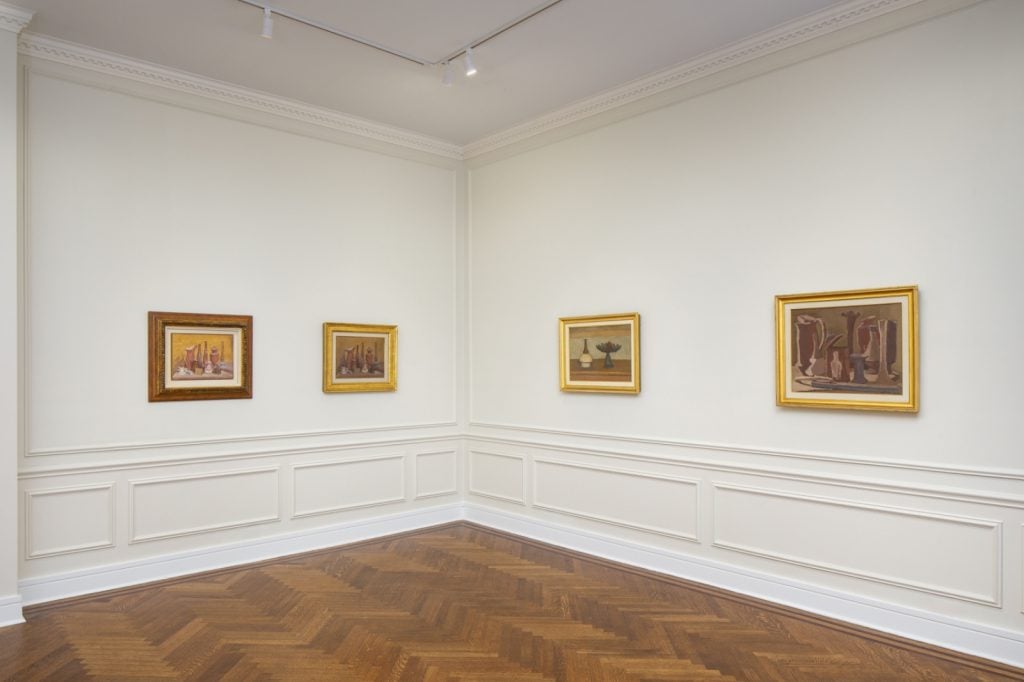
Installation view by Nicholas Knight
He was also a master printmaker. “In tones of black and grey, in his mark making, the etchings, his rigour is evident,” Mattia said. “In the watercolours you can clearly see his command of negative space. The simple outlines in the drawings are like paintings, with light coming through.”
On the wall of the winding staircase his flower paintings are on view; He often used paper roses for his subject. “Morandi was never attached to his work. He never sold any of his flower paintings. They were all gifts to friends because he felt they were too intimate.”
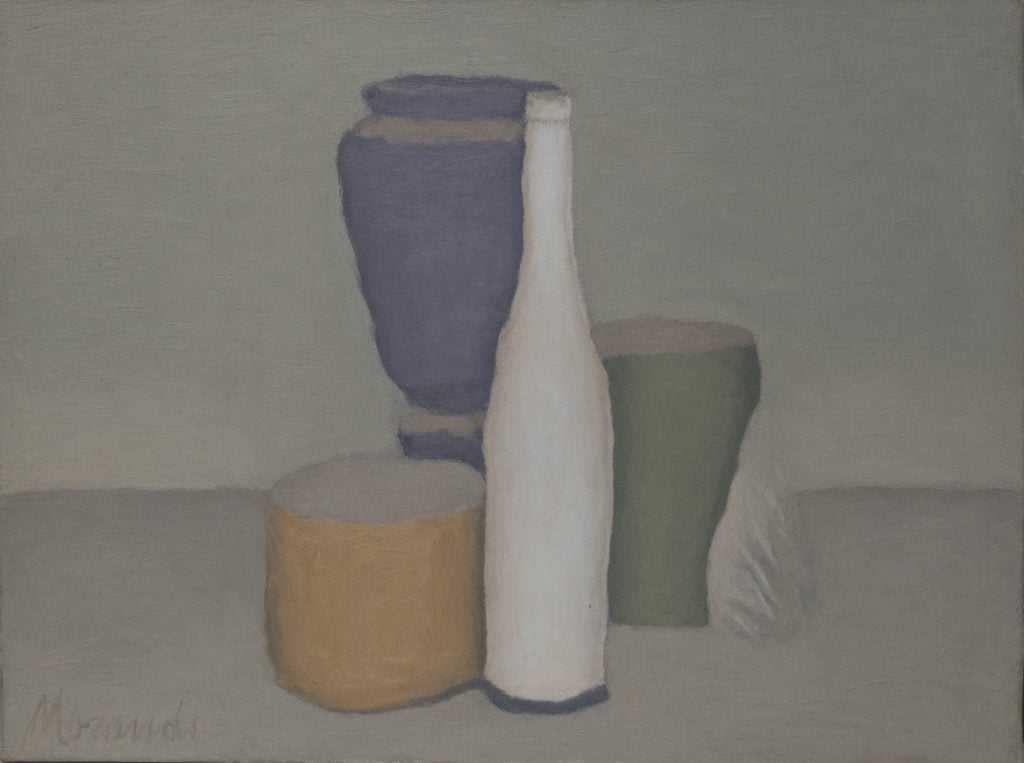
Giorgio Morandi Natura morta (V. 1188) signed: “Morandi” (lower left). Executed in 1960 (undated)
While the first floor of the town house is dedicated to his early works, on the second floor are paintings from the 1950s up to 1964, the year he died. “His still lifes are architectural. Geometric planes. Rectangles within rectangles within rectangles, layered. You can see his hand working. In one, the white bottle is strong and precise while the others are softly leaning into her.” In the sixth room, the last one in the exhibition, his strokes become looser, the colors more blurred, as if he is fading away.
It’s as if in the repetition of painting the ordinary, Morandi uncovered what was inside; it is that which haunts you, compelling you to return. There is always more to see if you open yourself to go beyond looking and allow the work to penetrate. That otherness that typifies his work only reveals itself through vulnerability, opening yourself up, and coming to the work without preconceptions. These works are an abstraction of reality. “Giorgio Morandi – Time Suspended II” affords us the opportunity to intimately engage with Morandi’s gift of perception. He painted worlds.
“Giorgio Morandi – Time Suspended II” is on view Galerie Mattia de Luca.

